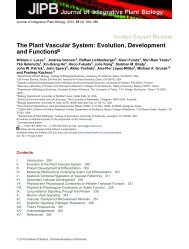Roles of SNARE Proteins in Synaptic Vesicle Fusion - Department of ...
Roles of SNARE Proteins in Synaptic Vesicle Fusion - Department of ...
Roles of SNARE Proteins in Synaptic Vesicle Fusion - Department of ...
You also want an ePaper? Increase the reach of your titles
YUMPU automatically turns print PDFs into web optimized ePapers that Google loves.
50 M.T. Palfreyman, E.M. Jorgensen<br />
calcium-dependent manner (200–204). Importantly, synaptotagm<strong>in</strong> appears to<br />
compete with complex<strong>in</strong> for <strong>SNARE</strong> complex b<strong>in</strong>d<strong>in</strong>g and relieves the clamp<br />
when calcium is present (reviewed <strong>in</strong> ref. 194). One possibility is that calcium<br />
b<strong>in</strong>d<strong>in</strong>g allows synaptotagm<strong>in</strong> to actively displace complex<strong>in</strong> from the <strong>SNARE</strong><br />
complex, which is then free to fully w<strong>in</strong>d and to break the membrane <strong>of</strong> the<br />
hemifused <strong>in</strong>termediate. In this model the <strong>SNARE</strong>s could function like a wheel,<br />
with complex<strong>in</strong> the stick <strong>in</strong> the spokes prevent<strong>in</strong>g the wheel from turn<strong>in</strong>g.<br />
Calcium b<strong>in</strong>d<strong>in</strong>g to synaptotagm<strong>in</strong> would pull the stick from the spokes and<br />
allow the wheel to turn and drive fusion. This model, however, rema<strong>in</strong>s speculative,<br />
and several pieces <strong>of</strong> data are currently <strong>in</strong>compatible with the above model.<br />
First, complex<strong>in</strong> knockout <strong>in</strong> mice do not have elevated synaptic vesicle fusion,<br />
as would be predicted (205). In addition, synaptotagm<strong>in</strong> when reconstituted with<br />
the neuronal <strong>SNARE</strong>s <strong>in</strong> the liposome fusion assay, can act alone as both a<br />
fusion clamp <strong>in</strong> the absence <strong>of</strong> calcium as well as an accelerator <strong>of</strong> fusion <strong>in</strong> the<br />
presence <strong>of</strong> calcium (206). However, a second group did not observe calcium<br />
sensitivity <strong>in</strong> <strong>SNARE</strong>-mediated liposome fusion assays by the addition <strong>of</strong> synaptotagm<strong>in</strong>;<br />
<strong>in</strong>stead, synaptotagm<strong>in</strong> simply accelerated the rate <strong>of</strong> liposome<br />
fusion <strong>in</strong>dependent <strong>of</strong> calcium (207). S<strong>in</strong>ce subsequent chapters will delve further<br />
<strong>in</strong>to the murky depths <strong>of</strong> calcium regulation, here we will suffice to stay <strong>in</strong><br />
the shallow end <strong>of</strong> the pool.<br />
Conclusion<br />
Rounds <strong>of</strong> <strong>SNARE</strong> assembly and disassembly lie at the center <strong>of</strong> all vesicular traffick<strong>in</strong>g.<br />
Assembly <strong>of</strong> the <strong>SNARE</strong>s <strong>in</strong>to a four-helix bundle drives fusion <strong>of</strong> synaptic<br />
vesicles with the plasma membrane and thereby mediates the release <strong>of</strong> neurotransmitter.<br />
The entw<strong>in</strong>ed <strong>SNARE</strong>s are then pulled apart by the ATPase NSF, which<br />
reenergizes the system for further rounds <strong>of</strong> fusion. This model is widely accepted,<br />
yet its details are <strong>in</strong> considerable dispute. So far, reconstitution experiments have<br />
exam<strong>in</strong>ed <strong>in</strong>teractions between only a very few <strong>of</strong> the prote<strong>in</strong>s <strong>in</strong>volved <strong>in</strong> what is<br />
undoubtedly a complex and highly regulated fusion mach<strong>in</strong>e. As such, they have<br />
given us largely static images <strong>of</strong> the complex. Thus, the overarch<strong>in</strong>g challenge <strong>in</strong><br />
the com<strong>in</strong>g years will be to understand the regulation <strong>of</strong> the <strong>SNARE</strong>s and how the<br />
assembly <strong>of</strong> <strong>SNARE</strong>s catalyzes fusion.<br />
Several questions must be resolved. First, is a preassembled Q-<strong>SNARE</strong> acceptor<br />
complex present on the plasma membrane <strong>in</strong> vivo, and if so how is it stabilized?<br />
Second, how is assembly <strong>of</strong> the <strong>SNARE</strong>s regulated? <strong>SNARE</strong> regulators, <strong>in</strong>clud<strong>in</strong>g<br />
MUN doma<strong>in</strong> prote<strong>in</strong>s such as Unc13, SM prote<strong>in</strong>s, and Tomosyn, have been identified,<br />
yet their mechanism <strong>of</strong> action is unclear. Third, are <strong>SNARE</strong>s fully zippered<br />
prior to or dur<strong>in</strong>g fusion? Fourth, is <strong>SNARE</strong> complex zipper<strong>in</strong>g arrested <strong>in</strong> the readily<br />
releasable pool <strong>of</strong> synaptic vesicles? Fifth, does formation <strong>of</strong> the <strong>SNARE</strong> complex<br />
generate a hemifusion <strong>in</strong>termediate? And f<strong>in</strong>ally, what rearrangements occur<br />
<strong>in</strong> the <strong>SNARE</strong> complex when synaptotagm<strong>in</strong> b<strong>in</strong>ds calcium and phospholipids?<br />
Wang_Ch03.<strong>in</strong>dd 50 5/15/2008 5:27:15 PM
















